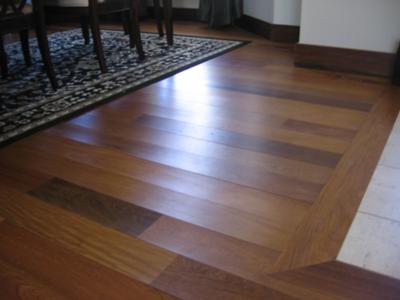Brazilian Walnut
Wood Floor
Water Damage Problem
Replace or Sand
by Jay Dowhaniuk
(Denver, CO USA)
The Owner of a Brazilian Walnut Wood Floor Water Damage Problem Writes:
Hello,
I have 5 inch Brazilian Walnut boards, 3/4 in. thick.
Two flooring companies say replace a specific section, while the insurance company contractors say we can go ahead and sand the cupping.
I am looking for your support to assure the insurance company contractors that sanding is not the way to go and technically why this is so.
We live in Denver, where the air is dry. We have a house humidifier ~25 to 30%.
The floor has been drying since Feb. 18, 2011.
We have had dehumdifiers in the house including, vacuum suction mats.
The floor moisture between the boards is 9%.
Thank you for your assistance.
The Director Responds
First of all, thank you for the good information AND photo. That helps me, greatly.
Brazilian Walnut is one of those exotics that tends to explode and not come back, leaving cracks between the boards when flat, again.
It does depend on the extent of the damage, however.
I would be curious to know what initial moisture readings were at the time of the damage.
100 percent, I know, but just before the driers were started, what did the moisture meter read?
Also, what does the moisture meter read on the unaffected portion of your floor?
That reading is your baseline. THAT is normal for YOUR house.
Sidebar: Be sure the same meter is used, all the time. The readings are relative, so it doesn't matter what type of meter, only that it is the same meter. (Not just the same model.)
If relative moisture content deviated 3% from normal (for your house,) then you will have cracks, eventually,
and possibly squeaks. Again, I am speaking only from my experience.
How big will those cracks be? Will they be unsightly?
Only time will tell. Only when your floor is dry and flat, again, will you know if you can live with the cracks.
Visually, it helps that the floor is dark in color.
BUT DO NOT SAND WHEN THE FLOOR IS CUPPED!
If you haven't already done so, refer your insurance agent AND your insurance adjuster to my wood floor cupping page.
He or she may also be interested in my ever-popular wood floors buckling page
Sanding is not an option, now, and because the floor WILL flatten out,
may not even be necessary in the future.
You can fill a crack, after all,
but there's no sanding out a squeak!
Replacing the damaged boards is your fastest solution to getting back to normal.
However, if this is a nail-down floor, then the sub floor also needs time to dry, otherwise the new floor will cup again.
Also, there can be big color and grade differences from mill to mill.
It would be good form to use the same mill and get some extra as a life line for the future.
Especially when we are talking exotics.
But what if the original mill cannot be determined or is no longer in business?
Then, resand a portion of your unaffected floor and lay the new boards on top to compare bare wood to bare wood.
(I would do this even if I did use the same mill.)
How long will it take for my floor to dry out on its own?
In Minnesota, where I live and write with a space heater at my feet until April,
the same floor that reads 9% in July can easily read 6% in January. So, I generally tell folks it will take a heating season.
You? What heating season?
Colorado is a fairly moderate state for seasonal interior wood moisture content readings.
According to my moisture map, (and, yes, I have a moisture map,)
Colorado floors see a seasonal swing of only a percentage point, at the most.
6% in January, as opposed to 7% in July, generally, a little drier in the western third of the state.
Despite the driers, a few weeks is not enough time for your floor to return to normal,
especially in Colorado where your heating season is more of a
warming plate than a Minnesota microwave.
If further documentation is worthwhile, you can visit the US Forest Products Laboratory.
Although your floor is not domestic wood, their research findings would be generically germane
to the dynamics of wood floor water damage.
Your insurance people are more than welcome to write me, as well.
As you can tell, my concern is for the longest life of your floor. I will always encourage the long view.
Keep in touch.
Made possible, in part, by:
 School of Lower Learning
School of Lower LearningDirector's Welcome
Below the Outlets
[?]Never Miss a New Post to The School of Lower Learning Bulletin Board. No Cork!





